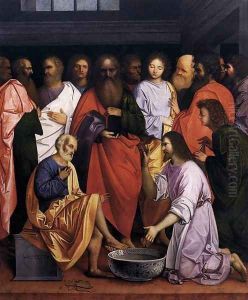Giovanni Da Bologna Paintings
Giovanni da Bologna, more commonly known as Giambologna, was an influential Mannerist sculptor, known for his marble and bronze sculptures in the late Renaissance period. Born Jean Boulogne in Douai, Flanders (now part of France) in 1529, he moved to Italy to study and work, where he eventually became one of the most important sculptors of his time. His work is characterized by its graceful figures, intricate detail, and the sense of movement it conveys, a departure from the more static and proportioned works of the High Renaissance.
Giambologna's training began in Antwerp, but it was in Italy, particularly in Rome, where he was deeply influenced by classical sculpture and the works of Michelangelo. He moved to Florence in 1553, where he entered the service of the Medici family, a position that provided him with significant commissions and allowed him to flourish artistically. His sculptures were not only innovative in their dynamism and the handling of space but also in their thematic explorations, often blending mythology with allegory.
Among his most famous works are the "Rape of the Sabine Women" and "Hercules beating the Centaur Nessus", both of which exemplify his skill in capturing complex, intertwined figures in a single block of marble. These works, among others, showcase Giambologna's mastery over the medium and his ability to depict dramatic narratives within the confines of sculpture. His influence extended beyond Italy, affecting the development of Baroque sculpture across Europe.
Giambologna's legacy is not limited to his sculptures; he was also an important figure in the development of the garden sculpture and contributed significantly to the decoration of the Boboli Gardens in Florence. His work there includes the Ocean Fountain, among others, which are notable for their elaborate design and integration into the landscape architecture. Giambologna died in Florence in 1608, leaving behind a body of work that continues to be admired for its beauty, technical skill, and artistic innovation. His sculptures are preserved in major museums around the world, standing as testaments to the enduring appeal of his artistry and the Mannerist style he helped define.

